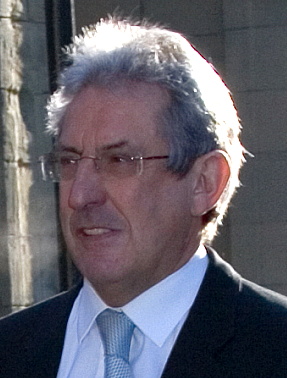Pedro Miguel Etxenike facts for kids
Quick facts for kids
Pedro Miguel Etxenike
|
|
|---|---|
 |
|
| Born |
Pedro Miguel Etxenike Landiribar
|
| Alma mater | University of Navarre, University of Cambridge, Autonomous University of Barcelona |
| Scientific career | |
| Fields | Semiconductor physics, surface physics, optical spectroscopy, plasmonics, topological insulators |
| Institutions | Donostia International Physics Center, University of the Basque Country, Cavendish Laboratory, Basque Government, University of Barcelona, Niels Bohr Institute, Oak Ridge National Laboratory |
| Thesis | Interaction of electronic particles with surfaces (1976) |
| Doctoral advisor | John Pendry |
| Doctoral students | Maia Vergniory |
Pedro Miguel Etxenike Landiribar, also known as Pedro Miguel Echenique, is a famous scientist from the Basque Country in Spain. He was born on June 8, 1950, in a town called Isaba, Navarre. He is a professor of physics and has also worked as a government minister.
He is known for his work in solid-state physics, which studies how materials behave. He teaches at the University of the Basque Country.
Contents
Early Life and Education
Pedro Etxenike grew up in a small village in Navarre. His father was a doctor, and his mother was a teacher. He had one brother and one sister.
He went to a special boarding school run by Capuchin friars. Later, he studied Physics at the University of Navarre. He graduated in 1972 with top honors.
In 1973, he continued his studies at the University of Cambridge in England. He earned his Ph.D. in 1976. His research was about how tiny particles interact with surfaces. He also received another doctorate from the Autonomous University of Barcelona in 1977.
Career in Science
After finishing his studies, Pedro Etxenike worked at important research centers. He was at the Oak Ridge National Laboratory in the United States. He also worked at the Niels Bohr Institute in Denmark.
In 1978, he became a professor at the University of Barcelona. He later returned to the Basque Country. In 1986, he became a Professor of Condensed Matter Physics at the University of the Basque Country.
Research and Discoveries
Professor Etxenike has written over 400 scientific papers. His research helps us understand how solid materials work. He studies how charged particles, like electrons, interact with surfaces.
One important idea he developed is "image-potential states." This is where electrons can get trapped near a metal surface. It's like they see their own reflection, which creates a force that holds them.
His work has helped improve tools like the scanning tunneling microscope (STM). This microscope lets scientists see tiny details on surfaces. He also studies how light and matter interact, especially with tiny waves called surface plasmons.
Pedro Etxenike has guided 27 students through their Ph.D. studies. He also encourages young people to get involved in science. He helps organize events like the "Passion for Knowledge" festival.
Awards and Recognition
Pedro Etxenike has received many important awards for his scientific work:
- In 1998, he won the prestigious Prince of Asturias Award.
- He also received the Max-Planck Research Award in 1998.
- In 2005, he was given the Blas Cabrera National Research Award.
- He became a full member of the Spanish Royal Academy of Sciences in 2017.
- In 2018, he was made an honorary member of the European Physical Society.
- He is also a Fellow of the American Physical Society.
He has received many honors in the Basque Country and Navarre. These include gold medals from universities and cities. He is also an "honored son" of his hometown, Isaba. Several universities, including Cambridge, have given him honorary doctorates.
Role in Government
In 1980, Pedro Etxenike took a break from his university job. He joined the first government of the Basque Autonomous Community. This was after the end of the Franco dictatorship in Spain.
He first served as the Minister of Education. In 1983, he became the Minister of Education and Culture. He was also the government's spokesperson until 1984.
One of his big achievements was helping create a law to promote the use of the Basque language. He also helped set up the education system in the Basque Country. This included promoting freedom in education and creating research centers.
After leaving government, he continued to help shape science policy in the Basque Country. He helped start many important research centers. He founded the Donostia International Physics Center (DIPC) in 1999. He also helped create the Centre for Materials Physics (CFM).
He was also involved in setting up the CIC nanoGUNE research center. From 2007 to 2012, he was the first president of Jakiunde, the Academy of Sciences, Arts and Letters of the Basque Country. He continues to chair the judging panel for the Princess of Asturias Prize for Scientific and Technical Research.
See also
 In Spanish: Pedro Miguel Echenique para niños
In Spanish: Pedro Miguel Echenique para niños

